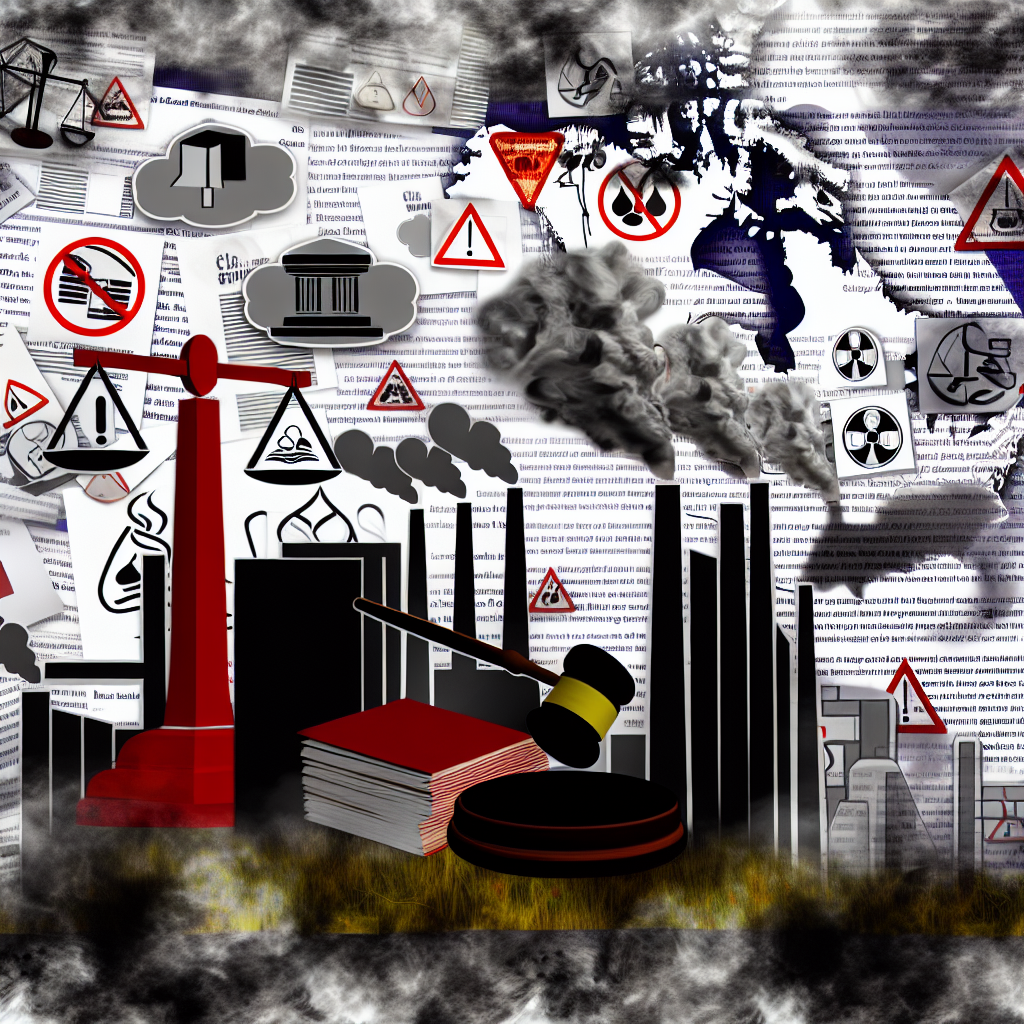In the vast landscape of North America, amidst the roaring engines of trucks and the intricate web of environmental policies, an urgent challenge looms large: the confusion surrounding emissions regulations. As manufacturers grapple with a tangled mesh of differing rules and standards between Canada and the U.S., the stakes have never been higher.
The race to meet ambitious emissions targets is more than just a compliance issue; it is a pivotal moment that could dictate the fate of our environment and the livelihoods of countless workers in the trucking sector. With deadlines looming and the pressure mounting, businesses are left caught in a whirlwind of uncertainty, desperately seeking clarity amid a storm of regulatory change.
The need for coherent and consistent emissions regulations has never been more critical, not just for industry stakeholders, but for the future of our planet.
As we dive into the current state of emissions regulations in North America, it is crucial to understand the statistics that underline this pressing issue. The United States has significantly advanced its emissions standards with the Environmental Protection Agency (EPA) setting a new bar for heavy-duty vehicles. As of December 2022, the EPA finalized standards that will enforce an over 80% reduction in nitrogen oxides (NOx) emissions from heavy-duty trucks by 2027. This ambitious regulatory change is expected to prevent up to 2,900 premature deaths annually and mitigate 18,000 cases of childhood asthma, translating into an estimated $29 billion in net benefits by 2045 (EPA).
In contrast, Canada is engaging in a parallel regulatory climate. As of 2023, the country has adopted GHG emissions standards that closely align with those of the United States, covering light-duty vehicles. For model year 2023, the average combined fleet emissions of light-duty vehicles in Canada were quantified at 0.039 grams/mile for NMOG+NOx, which is below its regulatory threshold of 0.044 grams/mile (Canada). Furthermore, zero-emission vehicles (ZEVs) have made significant inroads in the Canadian market, accounting for approximately 11% of all new registrations in 2023 compared to just under 10% in the U.S. (CER).
While both nations are striving for advancements in emissions reductions, the Canadian government introduced adjustments in 2025 waiving the 20% ZEV sales target for 2026 amidst economic challenges (Reuters). These statistics highlight the ongoing evolution in emissions regulations within North America and the critical nature of establishing clearer guidelines to facilitate compliance and innovation in the face of environmental challenges.
Expert Quotations on NOx Regulatory Changes
Industry leaders express a mix of concerns surrounding the upcoming 2027 NOx emissions standards, particularly focusing on the economic pressures and technological challenges they present.
Sean Waters, Vice President of Compliance and Regulatory Affairs at Daimler Truck North America, shares his sentiments:
“The most important thing the OEMs have been doing over the last five to seven years is getting ready for the 2027 NOx standards. However, we have to have the same regulations. Canada is a small market compared to the U.S., and consistent regulations are crucial for effective implementation.”
Krista Toenjes, General Manager of North America On-Highway Business at Cummins, expresses the current uncertainty:
“Right now we’re in a waiting game when it comes to 2027. We have our strategy to hit the 2027 emissions standards, which is 0.035 NOx, and it’s crucial that we receive a definitive direction soon to avoid further delays in our planning.”
Additionally, Scott McCandless, Chairman of the American Truck Dealers, emphasizes economic considerations:
“This rule imposes between $39 and $55 billion in new regulatory costs on the American economy. Such burdens threaten to increase consumer prices while also prolonging the operation of older, more polluting vehicles due to the high costs associated with compliance.”
Mike Roeth, Executive Director of the North American Council for Freight Efficiency, highlights alternative technological paths:
“We need to focus on advancing technologies that are already transforming the sector, like electric and hydrogen vehicles, instead of imposing intense pressure on compliance with outdated models.”
These quotations reflect a broader concern within the industry about the balance needed between achieving environmental goals and managing the operational and economic realities faced by many businesses involved in trucking and manufacturing.
The call for clarity and consistency in the regulatory landscape underscores the complexities ahead as stakeholders prepare for the 2027 standards.

Zero-Emission Vehicle Adoption Trends in North America
Zero-emission vehicle (ZEV) adoption in North America has experienced remarkable growth, underscored by key statistics and evolving trends across the region.
Current Adoption Statistics
- United States: In 2023, the U.S. reported a record-breaking 1.4 million sales of plug-in electric vehicles (PEVs), achieving a significant market share of 9.1%. This milestone marked the first time annual sales exceeded one million units, showcasing growing consumer acceptance and interest in electric vehicles.
- Canada: Similarly, by 2023, ZEVs made up over 10% of all new vehicle registrations in Canada, with the cumulative number of ZEVs on the road surpassing 500,000.
Regional Highlights
- California: California remains at the forefront of ZEV adoption in the U.S., registering nearly 450,000 new zero-emission vehicles in 2023 alone, amounting to 25% of all new vehicle registrations. This achievement allowed the state to surpass its goal of 1.5 million ZEVs two years ahead of the target.
- North Carolina: North Carolina matched its target of 80,000 electric vehicles in 2025, ahead of schedule, although reaching its ambitious goal of 1.25 million EVs by 2030 presents ongoing challenges.
Market Projections
- Electric Vehicle Market: J.D. Power estimates that electric vehicle sales will represent 36% of the U.S. retail market by 2030 and grow to 58% by 2035, indicating a robust shift towards ZEVs in upcoming years.
- North American Revenue Growth: The electric vehicle market is projected to generate approximately $138.7 billion in revenue by 2025, with an expected annual growth rate of 12.02%, reaching an estimated $218.3 billion by 2029.
Policy and Infrastructure Developments
- U.S. Emissions Standards: The White House’s Environmental Protection Agency (EPA) has introduced ambitious auto emissions standards that aim for 56% of new car sales to be electric by 2032 and targets a 49% emissions reduction by 2032 relative to 2026 levels.
- Charging Infrastructure Expansion: By 2024, North America surpassed 200,000 public charging stations, with over 30% facilitating fast charging. Continuous government-funded initiatives are pushing for infrastructure expansion, especially in rural and underserved areas.
These developments reflect a trajectory of robust zero-emission vehicle adoption in North America, propelled by supportive policies, infrastructure investments, and shifting consumer preferences. The outlook suggests a progressive transition to cleaner transportation options as more individuals and businesses increasingly embrace ZEVs.
Comparison of Emissions Regulations in the U.S. and Canada
| Regulation Aspect | U.S. Regulations | Canadian Regulations | Inconsistencies/Potential Impacts |
|---|---|---|---|
| NOx Reduction Targets | EPA’s NOx rule targets an 82.5% reduction by 2027, reducing NOx from 0.2 g/hp-hr to 0.035 g/hp-hr. | Canada has not yet finalized comparable NOx reduction targets. | Lack of alignment could lead to increased costs for manufacturers operating across borders due to differing compliance standards and potential market confusion. |
| GHG Phase 3 Rules | U.S. has established GHG Phase 3 rules effective through model year 2027. | Canada has yet to adopt U.S. GHG Phase 3 rules. | Inconsistent adoption of GHG rules could hinder competitive advantage for manufacturers in either market, affecting pricing, technology investment, and overall greenhouse gas reduction efforts. |
| Regulatory Approach | U.S. regulations are more prescriptive and focus on specific emission reduction numbers. | Canada follows a more flexible framework that aligns with provincial strategies but lacks uniformity nationally. | Different approaches could complicate compliance for manufacturers, leading to increased operational costs and potential disruptions in cross-border trade. |
| Impact on Market | Stricter regulations may drive innovation but increase compliance costs. | Delayed regulations may slow down technological advancements and investments in cleaner technology. | Market uncertainty due to varying regulations could deter investment in the trucking sector, impeding efforts to transition to cleaner technologies effectively. |
This comparison table illustrates the contrasting landscape of emissions regulations between the U.S. and Canada, emphasizing key inconsistencies and their likely impacts on the trucking market.
Analysis of Regulatory Impacts on the Trucking Industry and Zero-Emission Compliance Efforts
The United States and Canada have historically aligned their emissions regulations for the trucking industry. This alignment recognizes the integrated nature of the North American market, but recent developments have indicated emerging differences in their approaches to zero-emission compliance for heavy-duty vehicles.
United States Regulations
In March 2024, the U.S. Environmental Protection Agency (EPA) finalized stricter tailpipe emissions standards for heavy-duty vehicles, including semi-trucks and buses. These standards are set to be implemented between 2027 and 2032. Their aim is to prevent one billion tons of greenhouse gas emissions by 2055. Moreover, these regulations are projected to provide $13 billion in annual net benefits.
The new rules apply to various vehicles, such as delivery trucks and school buses. They adopt a technology-neutral approach, allowing manufacturers to choose emissions control technologies that best suit their needs. However, industry groups have expressed concerns about the costs and feasibility of complying with these new rules [Reuters].
Additionally, the EPA has set ambitious targets for zero-emission vehicle (ZEV) adoption. By 2032, 67% of new light-duty vehicle sales are expected to be electric. For heavy-duty vehicles, the standards foresee varying requirements, including 30% zero-emission for “heavy-heavy-duty vocational” trucks and 40% for short-haul “day cabs” by 2032 [AP News].
Canada’s Approach
Canada has traditionally aligned its vehicle emissions standards with those of the U.S. This consistency is crucial for maintaining competitiveness within its automotive industry. However, recent reports suggest Canada is lagging in the transition to zero-emission heavy-duty vehicles. In 2023, only 2% of new trucks and buses sold in Canada were zero-emission, compared to 9% globally. California, for example, is leading the way, with 17% of new commercial vehicle sales being zero-emission models [Truck News].
To address this gap, Canada has committed to developing a medium- and heavy-duty zero-emission vehicle regulation. This aims for 35% of total new medium- and heavy-duty vehicle sales to be zero-emission by 2030. The long-term goal is to achieve 100% by 2040 for certain vehicle types based on feasibility. Importantly, the government is also working on aligning its regulations with California’s Advanced Clean Trucks regulation. This regulation requires manufacturers to sell an increasing percentage of zero-emission trucks starting in 2024 [Transport Canada].
Impacts of Regulatory Discrepancies
The differences in emissions regulations between the U.S. and Canada have several implications:
- Market Competitiveness: Canadian trucking companies operating in the U.S. must comply with American regulations. This includes the use of Electronic Logging Devices (ELDs) and adherence to the International Fuel Tax Agreement (IFTA). Such requirements add administrative complexity and potential costs for Canadian carriers [Better This World].
- Environmental Goals: Canada’s slower adoption of zero-emission vehicles could hinder its ability to meet international climate commitments. The Canadian Trucking Alliance has urged the federal government to remain aligned with U.S. emissions regulations. This alignment will ensure a level playing field and avoid economic disadvantages [Truck News].
- Economic Opportunities: Aligning with stringent emissions standards can stimulate local manufacturing and innovation in the zero-emission vehicle sector. Remarkably, Canada’s EV battery supply chain could support up to 250,000 jobs by 2030 and add $48 billion to the economy annually [Clean Energy Canada].
In summary, while both countries aim to reduce emissions from the trucking industry, the U.S. has implemented more aggressive regulations and targets for zero-emission vehicle adoption. Canada’s current lag in this transition poses challenges but also presents economic growth and environmental benefit opportunities if alignment with U.S. standards is pursued.
Conclusion and Call to Action
As we have explored throughout this article, the need for coherent emissions regulations across North America has reached a critical juncture. With escalating targets set by the U.S. Environmental Protection Agency and varying commitments from Canada, the confusion surrounding differing standards poses significant challenges for manufacturers and stakeholders in the trucking industry. The complexities of navigating these regulations can lead to operational inefficiencies, increased costs, and hinder technological advancements in zero-emission vehicles, threatening both industry competitiveness and environmental goals.
To move forward, it is imperative that policymakers and industry stakeholders prioritize regulatory clarity and uniformity. By aligning emissions standards and working collaboratively across borders, we can foster innovation, reduce compliance burdens, and accelerate the transition to sustainable transportation solutions. The time for decisive action is now—let us advocate for a harmonized regulatory framework that not only supports the trucking industry but also contributes to a healthier planet for future generations.
Join us in urging decision-makers to place clear emissions regulations at the forefront of their agendas, ensuring a robust and competitive environment for sustainable transport in North America.
Call to Action:
Contact your local representatives to emphasize the importance of clear emissions regulations and support initiatives that promote uniform standards between Canada and the U.S. Together, we can drive change for a cleaner future.
Historical Context of Emissions Regulations in North America
The evolution of emissions regulations in North America has been profoundly shaped by rising environmental concerns and the impact of transportation on air quality. The historical context began in the late 1960s and early 1970s when the United States experienced severe air pollution episodes that prompted the establishment of the Clean Air Act in 1970. This landmark legislation set the stage for regulating pollutants and addressing the public health crisis caused by vehicle emissions. In 1975, the first fuel economy and emissions standards for automobiles were introduced, marking a significant step towards cleaner air.
In the following decades, the U.S. Environmental Protection Agency (EPA) implemented stricter standards, compelling manufacturers to innovate and adopt cleaner technologies. The mid-1990s saw the advent of Tier 1 standards, which targeted reductions in nitrogen oxides (NOx) and particulate matter, further propelling the industry towards lower emissions.
Canada mirrored these developments with its own regulatory framework, notably aligning with U.S. standards to ensure consistency across borders. This collaboration became more pronounced with the introduction of the Canadian Environmental Protection Act in 1999, which laid out a comprehensive strategy for managing pollutants from various sources, including vehicles.
The late 2000s ushered in the push for more rigorous standards, culminating in the 2010 establishment of the U.S. EPA’s National Program for Greenhouse Gas Emissions and Fuel Efficiency Standards, which aimed to harmonize regulations for light-duty vehicles across both nations. This regulatory alignment was crucial not only for simplifying compliance for manufacturers but also in fortifying commitments to combat climate change.
Fast forward to recent years, and we see the Biden administration advocating for even more ambitious targets for emissions reductions, particularly for heavy-duty trucks, highlighting a significant shift toward decarbonization strategies. As we stand on the cusp of major regulatory changes expected to take full effect by 2027, understanding this historical context is vital for grasping the complexities of current emissions debates and the urgent need for clarity moving forward.

Integration of Emissions Compliance, Greenhouse Gas Benefits, and Sustainable Trucking Initiatives
The legislative landscape surrounding emissions compliance plays a crucial role in shaping the trucking industry. As regulations become more stringent, the emphasis placed on emissions compliance is vital for manufacturers to adapt to the changing environmental standards. Initiatives geared towards sustainable trucking not only aim to meet compliance but also significantly contribute to greenhouse gas benefits, thus fostering a more environmentally friendly industry.
Sustainable trucking initiatives spearheaded by industry leaders underscore the vital role of innovation and technology adoption to enhance emissions compliance effectively. By prioritizing the transition to zero-emission vehicles (ZEVs), companies are not only adhering to regulatory demands but also positioning themselves as leaders in the drive towards ecological sustainability. The greenhouse gas benefits derived from a widespread adoption of ZEVs underlines how critical these initiatives are to achieving long-term environmental goals.
In summary, the intersection of emissions compliance, greenhouse gas benefits, and sustainable trucking initiatives serves as a beacon for the industry’s future, steering it towards a more sustainable operational model. Stakeholders must navigate these complexities to ensure a balance is struck between compliance and environmental stewardship, paving the way for a more resilient trucking sector that meets both market and regulatory expectations.
Zero-Emission Vehicle Adoption Trends in North America
Zero-emission vehicle (ZEV) adoption in North America has not only grown rapidly but is also marked by key statistics over the last few years.
Current Adoption Statistics
- United States: In 2023, a record-breaking 1.4 million plug-in electric vehicles (PEVs) were sold, achieving a significant market share of 9.1%. This milestone highlighted the growing consumer acceptance and interest in electric vehicles.
- Canada: By 2023, ZEVs also made up over 10% of all new vehicle registrations in Canada, with the cumulative number of ZEVs on the road surpassing 500,000.

This image showcases the trends in zero-emission vehicle adoption and regulations in North America, providing insights into increasing adoption rates among consumers.
Market Projections
- Electric Vehicle Market: Projections from J.D. Power estimate that electric vehicle sales will represent 36% of the U.S. retail market by 2030 and grow to 58% by 2035.
- North American Revenue Growth: The electric vehicle market is anticipated to generate approximately $138.7 billion in revenue by 2025, growing at an annual rate of 12.02% to reach an estimated $218.3 billion by 2029.
Policy and Infrastructure Developments
- U.S. Emissions Standards: The White House’s EPA has introduced ambitious auto emissions standards aiming for 56% of new car sales to be electric by 2032, alongside a 49% emissions reduction relative to 2026 levels.
- Charging Infrastructure Expansion: In 2024, North America surpassed 200,000 public charging stations, over 30% of which facilitate fast charging. Continuous government-funded initiatives are pushing for infrastructure expansion, particularly in rural areas.
These developments illustrate a promising trajectory of ZEV adoption in North America, fueled by supportive policies, infrastructure investments, and evolving consumer preferences.
Comparison of Emissions Regulations in the U.S. and Canada
| Regulation Aspect | U.S. Regulations | Canadian Regulations | Inconsistencies/Potential Impacts |
|---|---|---|---|
| NOx Reduction Targets | EPA’s NOx rule targets an 82.5% reduction by 2027, reducing NOx from 0.2 g/hp-hr to 0.035 g/hp-hr. | Canada has not yet finalized comparable NOx reduction targets. | Lack of alignment could lead to increased costs for manufacturers operating across borders due to differing compliance standards and potential market confusion. |
| GHG Phase 3 Rules | U.S. has established GHG Phase 3 rules effective through model year 2027. | Canada has yet to adopt U.S. GHG Phase 3 rules. | Inconsistent adoption of GHG rules could hinder competitive advantage for manufacturers in either market, affecting pricing, technology investment, and overall greenhouse gas reduction efforts. |
| Regulatory Approach | U.S. regulations are more prescriptive and focus on specific emission reduction numbers. | Canada follows a more flexible framework that aligns with provincial strategies but lacks uniformity nationally. | Different approaches could complicate compliance for manufacturers, leading to increased operational costs and potential disruptions in cross-border trade. |
| Impact on Market | Stricter regulations may drive innovation but increase compliance costs. | Delayed regulations may slow down technological advancements and investments in cleaner technology. | Market uncertainty due to varying regulations could deter investment in the trucking sector, impeding efforts to transition to cleaner technologies effectively. |
By addressing these inconsistencies, stakeholders can pave the way for a more efficient and cohesive strategy towards emissions regulations and support the transition to zero-emission vehicles.


